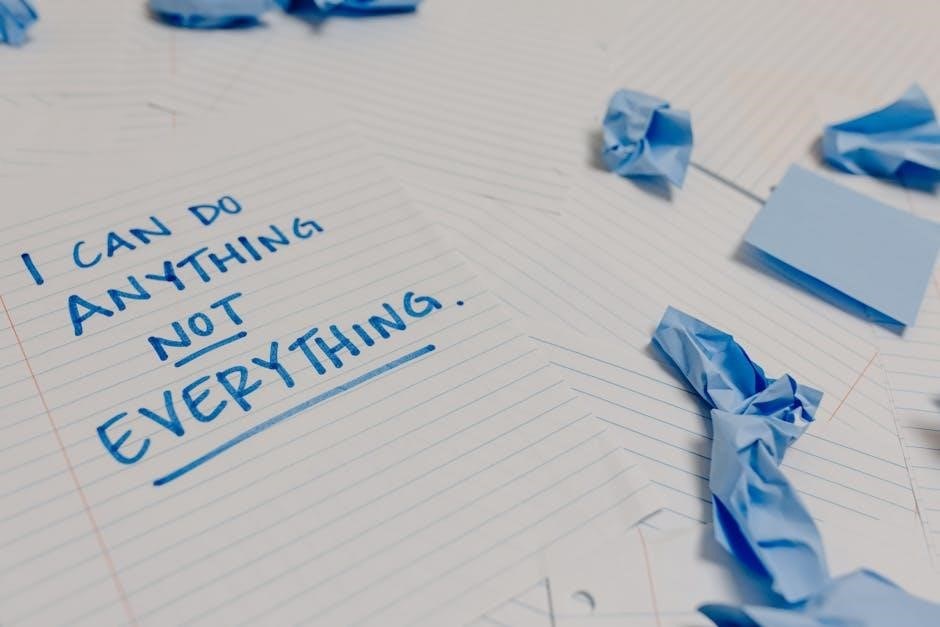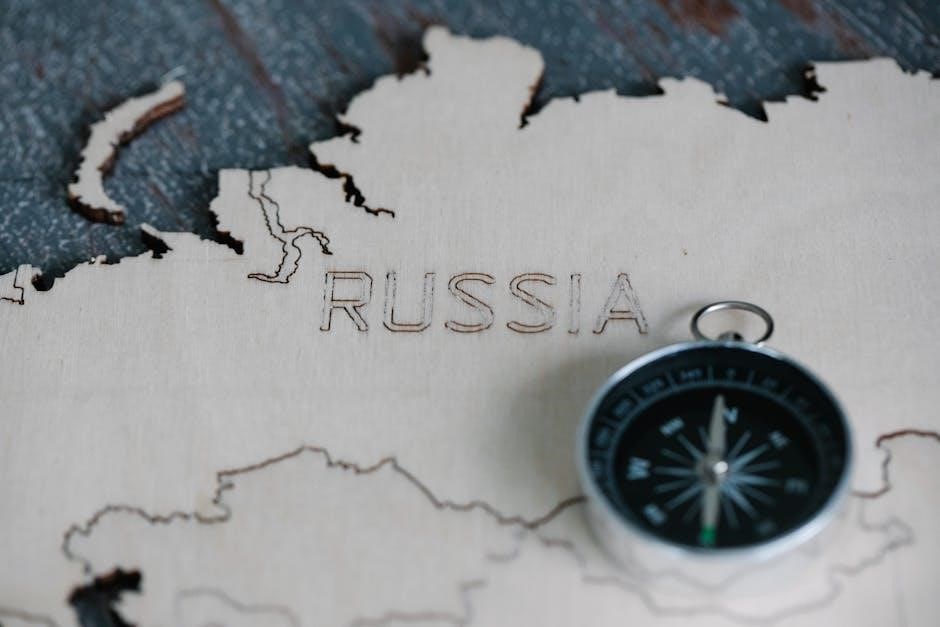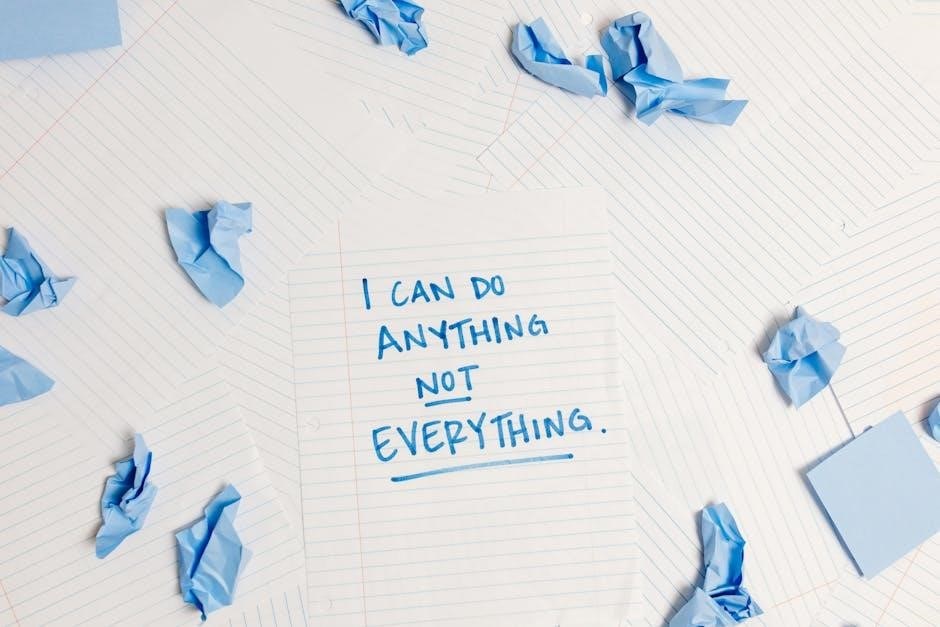Embrace minimalism by simplifying your life and freeing yourself from unnecessary possessions. This guide helps you declutter effectively, creating space for what truly matters. Start small, focus on essentials, and gradually let go of the rest to achieve a more organized and peaceful lifestyle.
What is Minimalism?
Minimalism is a lifestyle centered on simplicity, freedom from consumerism, and intentional living. It involves surrounding yourself with only what adds value, serves a purpose, or brings joy. By letting go of unnecessary possessions, minimalism creates space for clarity, focus, and meaningful experiences. It’s not about depriving yourself but about living intentionally, free from the burden of excess. This approach encourages a mindset shift, helping you prioritize what truly matters and find fulfillment in simplicity rather than stuff.
Why Decluttering is Essential for a Simplified Life
Decluttering is fundamental to embracing minimalism, as it removes distractions, reduces stress, and creates a sense of clarity. By letting go of unnecessary items, you free up physical and mental space, allowing you to focus on what truly matters. Clutter often leads to feelings of overwhelm and anxiety, while a simplified environment fosters peace and productivity. Decluttering also encourages intentional living, helping you avoid impulse purchases and waste. It’s a crucial step toward financial savings, better organization, and a more fulfilling life aligned with your values. Simplifying your surroundings empowers you to live more mindfully and appreciate the things that bring true joy and purpose.
The Benefits of Living with Fewer Possessions
Living with fewer possessions offers numerous benefits, including reduced stress, financial savings, and a clearer mind. A minimalist lifestyle minimizes clutter, making spaces easier to maintain and organize. Fewer belongings mean less time spent cleaning, repairing, and replacing items, allowing for more time to focus on meaningful activities. It also fosters gratitude for what you already have, reducing the urge to overconsume. Financially, buying less leads to savings and the opportunity to invest in quality over quantity. Additionally, minimalism promotes sustainability by reducing waste and encouraging mindful consumption. overall, it creates a simpler, more intentional way of living that aligns with personal values and priorities.
How to Start Your Journey to Minimalism
Begin your minimalist journey by addressing small areas or categories, such as your closet or kitchen tools. Apply the 30-day rule: if an item hasn’t been used in a month, consider letting it go. Declutter by focusing on items that no longer serve a purpose or bring joy. Keep only what is essential or meaningful. Sustain your lifestyle by being mindful of purchases and avoiding unnecessary additions. Remember, minimalism is about intentional living, focusing on what truly adds value to your life. Start with manageable steps, and gradually embrace a simpler, more organized way of living.

Assessing Your Possessions
Evaluate each item to determine its value or purpose. Use the “Maybe” box for undecided items and apply the 30-day rule to check usage. This process helps identify what truly matters, guiding intentional decisions on what to keep or discard.
Tips for Beginners: Where to Start Decluttering
Begin your decluttering journey by starting small, such as clearing a single drawer or shelf. Focus on high-impact areas like entryways or kitchen counters to see immediate results. Sort items into categories—keep, donate, discard—and use boxes or bins to organize the process. Consider the “Maybe” box for items that are hard to decide on, and revisit them later. Prioritize items that bring joy or serve a purpose. Tackle one space at a time to avoid feeling overwhelmed. Remember, decluttering is a process, and small steps lead to big changes. Keep motivated by imagining the freedom and clarity a clutter-free life brings.
How to Identify Items You No Longer Need or Love
To identify items you no longer need or love, start by asking yourself when you last used them and if they bring joy or serve a purpose. If an item is broken, outdated, or unused in the past year, consider letting it go. Use the “30-Day Rule”: if you don’t miss or need something after a month, it’s likely unnecessary. For sentimental items, take a photo or create a memory box to preserve memories without clutter. Sort items into “keep,” “donate,” and “discard” piles, and be honest about each item’s value in your life. This process helps declutter effectively and focus on what truly matters.
The Importance of Emotional Detachment from Possessions
Emotional detachment from possessions is crucial for effective decluttering. Many items hold sentimental value, making it hard to let go, but clutter often stems from emotional attachment. Learning to separate memories from physical objects frees you from the weight of unnecessary belongings. Start by acknowledging the emotional significance of an item, then ask if it truly adds value to your life. If not, consider letting it go. Keeping everything “just in case” can lead to a cluttered, stressful environment. Detachment allows you to focus on what truly matters, creating a simpler, more organized space. Practice gratitude for the item’s purpose and release it with confidence.
Creating a List of Essential Items to Keep
Creating a list of essential items to keep is a vital step in your minimalist journey. Start by categorizing your possessions and evaluating their importance. Ask yourself if each item serves a purpose or brings joy. Focus on functionality and personal value, rather than sentimental attachment. Prioritize items that are used regularly or hold significant meaning. Be ruthless with duplicates or items that no longer fit your lifestyle. Once your list is complete, it will serve as a guide to ensure you only keep what truly matters. Regularly review and update your list to maintain a balanced and intentional approach to your belongings.

Decluttering Techniques

Effective decluttering involves strategies like the “One In, One Out” rule, the 30-Day Rule, and using a “Maybe” Box for undecided items. These methods help streamline your process.
The “One In, One Out” Rule
The “One In, One Out” rule is a simple yet effective decluttering technique. For every new item you bring into your home, remove an old one to maintain balance. This rule prevents clutter from building up and helps you stay mindful of your possessions. It encourages intentional consumption and ensures your space remains organized. Apply it to clothes, books, or kitchen gadgets—any category where clutter tends to accumulate. By adhering to this rule, you’ll avoid overcrowding and keep only what truly adds value to your life. It’s a sustainable way to maintain a minimalist lifestyle over time.
How to Implement the 30-Day Rule for Decluttering
The 30-Day Rule is a practical decluttering strategy that helps you decide what to keep or discard. When considering an item, wait 30 days before deciding whether to keep it. If you don’t miss or need it during this period, it’s likely safe to let it go. Start by identifying items you’re unsure about, such as clothes, gadgets, or books. Place them in a designated area or mark them with a date. After 30 days, evaluate your feelings about each item. If it no longer serves a purpose or brings joy, consider removing it. This rule helps reduce attachment to unnecessary items and fosters a more intentional approach to possessions.
Decluttering by Category: A Step-by-Step Guide

Decluttering by category is an efficient way to organize and simplify your space. Start by grouping similar items, such as clothes, books, or kitchen gadgets, and evaluate each category separately. For clothing, sort items into keep, donate, or discard piles, focusing on what fits and brings value. In the kitchen, remove unused gadgets and expired food. For sentimental items, consider digitizing memories or keeping only a few meaningful pieces. Once sorted, review each category to ensure only essentials remain. This method helps you address clutter systematically without feeling overwhelmed, allowing you to create a more intentional and organized living environment.
The Power of the “Maybe” Box for Undecided Items
The “Maybe” Box is a strategic tool for decluttering, helping you handle items that are difficult to decide on. Place items you’re unsure about into a box and label it with the current date. Set a deadline, such as six months, to revisit the box. If you haven’t used or thought about an item by then, consider letting it go. This method reduces decision fatigue while allowing time to reflect on each item’s importance. It’s especially useful for sentimental or functional items that don’t spark immediate joy. By using the “Maybe” Box, you can declutter more effectively without the pressure of making final decisions upfront.

Responsible Disposal of Unwanted Items
Dispose of unwanted items thoughtfully by donating, recycling, or selling. This approach supports sustainability and ensures your discarded goods find new purposeful homes efficiently.
How to Donate Gently Used Items
Donating gently used items is a meaningful way to declutter while supporting others. Start by assessing the condition of your items to ensure they are still usable. Research local charities, shelters, or organizations that align with your values to maximize the impact of your donation. Consider using platforms like Freecycle or Buy-Nothing groups to give items directly to those in need. Clothing, furniture, and household goods are often in high demand. Remember to obtain receipts for tax-deductible donations, which can provide additional benefits. By donating, you not only declutter your space but also contribute to a more sustainable and compassionate community.
Guide to Selling Unwanted Items for Profit
Selling unwanted items is a great way to declutter and earn extra cash. Start by identifying items in good condition that have resale value, such as electronics, furniture, or clothing. Research platforms like eBay, Craigslist, or Facebook Marketplace to find the best place to sell. Take clear, well-lit photos and write detailed descriptions to attract buyers. Price items competitively by checking similar listings. Consider hosting a garage sale or using apps like Poshmark or Depop for convenience. Be responsive to inquiries and negotiate fairly. For bulk items, consignment shops or local buy-sell-trade groups can be effective. Selling not only declutters your space but also turns unwanted items into profit, supporting your minimalist journey while benefiting others.
The Importance of Recycling and Proper Disposal
Recycling and proper disposal are crucial steps in minimalism, ensuring items are handled responsibly. Start by separating materials like paper, glass, and metal for recycling. Donate gently used items to charities or local communities. For broken or unusable items, check local guidelines for proper disposal to avoid environmental harm. Consider using designated facilities for hazardous waste like batteries or electronics. Recycling reduces landfill waste and supports sustainability. Proper disposal also helps preserve natural resources and reduce pollution. By thoughtfully managing unwanted items, you contribute to a healthier planet while maintaining your minimalist goals. Always prioritize eco-friendly options to make a positive impact.
How to Participate in Local Buy-Nothing Groups
Joining local Buy-Nothing groups is a great way to declutter and give items a new home. Start by finding your area’s group, often on platforms like Facebook or local community apps. Once joined, post clear photos and descriptions of items you wish to give away. Follow group rules and engage respectfully with members; This method fosters community connection and reduces waste. It’s an eco-friendly way to declutter while benefiting others. Many groups also allow you to request items, promoting sharing and reuse. Participating not only simplifies your life but also strengthens local bonds and supports sustainable living.

Maintaining a Minimalist Lifestyle
Adopt daily habits like the “one in, one out” rule and regular decluttering sessions. Focus on what adds value and practice emotional detachment to sustain simplicity and freedom.
Creating Habits for Long-Term Minimalism
Developing consistent habits is key to maintaining a minimalist lifestyle. Start with small, manageable routines, such as the “one in, one out” rule or weekly decluttering sessions. Focus on intentional consumption and prioritize items that add value to your life. Practice mindfulness when acquiring new possessions and regularly assess what no longer serves you. Implementing these habits fosters a mindset of simplicity and sustainability. Over time, these practices become second nature, helping you maintain a clutter-free space and reduce decision fatigue. By staying committed to your values, you’ll cultivate a lifestyle that emphasizes what truly matters.
- Adopt daily habits like tidying up for 10 minutes.
- Review your belongings monthly to ensure everything still fits your minimalist goals.
- Focus on quality over quantity in purchases.
- Practice gratitude for what you already have.
Consistency is the cornerstone of long-term minimalism, ensuring your space and life remain clutter-free and purposeful.
How to Avoid Recluttering Your Space
To prevent your space from becoming cluttered again, adopt intentional habits and maintain regular routines. Implement the “one in, one out” rule to ensure new items don’t overwhelm your space. Schedule weekly decluttering sessions to keep your environment organized; Avoid impulse purchases by practicing mindful consumption and using the 30-day rule for non-essential items. Create a designated spot for daily items like keys or mail to prevent scattering. Regularly review your belongings to ensure they still align with your minimalist goals. By staying consistent and focused, you’ll maintain a clutter-free home and reduce the likelihood of relapse.
- Set reminders for monthly decluttering checks.
- Designate zones for items like paperwork or accessories.
- Practice gratitude before buying to avoid unnecessary purchases.
Consistency and intentionality are key to sustaining a clutter-free lifestyle.
Strategies for Maintaining a Clutter-Free Home
Maintaining a clutter-free home requires consistent effort and intentional habits. Start by creating a daily routine that includes tidying up for 10-15 minutes. Use the “one in, one out” rule to prevent accumulation of new items. Assign a designated spot for each item to ensure everything stays organized. Schedule weekly decluttering sessions to address any new clutter. Practice mindful consumption by avoiding impulse purchases. Utilize storage solutions wisely to maximize space without overcrowding. Regularly review and purge items that no longer serve a purpose. By implementing these strategies, you can sustain a clutter-free environment that fosters peace and productivity.
- Adopt a “home for everything” approach.
- Involve family members in maintenance tasks.
- Celebrate small victories to stay motivated.
How to Handle Gifts in a Minimalist Lifestyle
Handling gifts in a minimalist lifestyle can be challenging but manageable with thoughtful strategies. Always express gratitude for the gesture, regardless of whether you keep the item. Politely decline gifts that don’t align with your values or needs. For received gifts, consider the “one in, one out” rule to maintain balance. If an item no longer serves you, donate or repurpose it respectfully. Communicate your minimalist preferences to loved ones to guide their gifting choices. Focus on experiences or practical items that enhance your life. Remember, the intention behind the gift matters more than the item itself.
- Set boundaries with gift-givers.
- Create a “maybe” box for undecided items.
- Encourage non-material gifts like experiences.

The Benefits of a Simplified Life
A simplified life reduces stress, saves money, and fosters mental clarity. It encourages gratitude, sustainability, and focus on what truly matters, enhancing overall well-being.
How Minimalism Improves Mental Clarity
Minimalism improves mental clarity by reducing mental clutter. A simplified environment minimizes distractions, allowing focus on what truly matters. By letting go of unnecessary possessions, individuals gain freedom from decision fatigue and emotional burdens tied to belongings. This clarity fosters better concentration, creativity, and problem-solving skills. A decluttered space promotes a sense of calm, reducing stress and anxiety. Minimalism encourages intentional living, helping prioritize thoughts and actions. With fewer distractions, the mind can better process information and maintain focus. This mental freedom leads to increased productivity and a greater sense of control over life. Embracing minimalism creates a clearer, more organized mindset, enhancing overall well-being.
The Financial Savings of Living with Fewer Possessions
Living with fewer possessions leads to significant financial savings. By reducing impulse purchases and focusing on essentials, individuals spend less on unnecessary items. Decluttering often reveals hidden treasures, allowing resale of unused goods for profit. Maintenance and storage costs decrease as fewer belongings require care. The “One In, One Out” rule prevents accumulation, saving money over time. Minimalism encourages buying higher-quality, long-lasting items, reducing frequent replacements. Additionally, selling unwanted items generates income, while donating can offer tax benefits. This mindful approach fosters financial freedom, helping individuals save, invest, and allocate resources to meaningful experiences rather than material goods.
How Decluttering Can Reduce Stress and Anxiety
Decluttering significantly reduces stress and anxiety by creating a calmer, more organized environment. Clutter overstimulates the mind, leading to feelings of overwhelm and chaos. By removing unnecessary items, individuals gain a sense of control and clarity. A tidy space fosters better focus and improved mental well-being. Decluttering also eliminates distractions, allowing the mind to rest and recharge. Many find the process therapeutic, as letting go of unused items symbolizes releasing emotional burdens. Starting small and gradually decluttering can make the task less daunting, leading to a more peaceful and stress-free lifestyle. This simplicity promotes emotional calm and a greater sense of freedom.
The Environmental Impact of Minimalism
Minimalism significantly reduces environmental impact by promoting sustainable living. By owning fewer possessions, individuals contribute less to waste and resource depletion. Decluttering reduces the need for constant consumption, lowering carbon footprints from production and transportation. Minimalist practices encourage reusing and repurposing items, diverting waste from landfills. Donating or recycling unwanted goods supports a circular economy, benefiting both communities and the planet. Embracing minimalism also fosters a mindset of mindful consumption, discouraging impulse buying and encouraging investment in durable, eco-friendly products. This shift not only preserves natural resources but also inspires others to adopt greener lifestyles, creating a ripple effect for global environmental sustainability.

Advanced Decluttering Strategies
Mastering minimalism involves advanced techniques like the “One In, One Out” rule, the 30-Day Rule, and the “Maybe” Box to efficiently declutter and maintain a clutter-free space.
How to Declutter Sentimental Items
Decluttering sentimental items can be emotionally challenging but is crucial for a minimalist lifestyle. Start by acknowledging the memories attached to each item. Photograph items before letting them go to preserve memories digitally. Create a “memory box” for a few select items that hold the most significance. Set boundaries by deciding how much space you’re willing to allocate for sentimental items. Focus on the joy these items bring—keep only those that evoke positive emotions. Let go of items that cause guilt or clutter. Remember, the memory lives on, not in the object itself. This process helps create a balanced, clutter-free space while honoring meaningful memories.
Strategies for Decluttering Digital Clutter
Decluttering digital spaces is essential for a minimalist lifestyle. Start by organizing files into clear, labeled folders and backing up important data to cloud storage. Unsubscribe from unnecessary emails and delete outdated messages. Regularly clean up your computer and phone by removing unused apps and outdated files. Consider implementing a “one in, one out” policy for digital content. Simplify your social media by unfollowing unnecessary accounts and muting noisy channels. Schedule regular digital clean-ups to maintain clarity and focus. Remember, a clutter-free digital life reduces stress and improves productivity, allowing you to focus on what truly matters.
How to Declutter Your Wardrobe Effectively
Start by taking everything out of your closet to assess what you have. Use the hanger trick: hang clothes with the hanger facing the wrong way and remove items that remain unworn after a month. Apply the 30-day rule for undecided pieces—place them in a “maybe” box and discard them if unused after 30 days. Focus on keeping only what fits well, is in good condition, and brings joy. Sort items into three piles: keep, donate/sell, and discard. Consider the 80/20 rule—80% of the time, you likely wear 20% of your clothes. Store out-of-season items neatly and adopt a “one in, one out” policy to prevent clutter from building up again. This approach will help you maintain a streamlined, functional wardrobe that reflects your personal style and simplifies your daily routine.
How to Declutter Your Kitchen and Dining Areas
Start by clearing off countertops and sorting items into categories: baking supplies, cooking utensils, and dining essentials. Discard expired or unused food and gadgets. Keep frequently used items in easy-to-reach locations and store less-used items in higher cabinets or labeled containers. Apply the “one in, one out” rule to prevent clutter buildup. For the dining area, declutter tables and shelves, keeping only what enhances meals. Consider donating gently used kitchenware or selling items in good condition. Maintain a minimalist kitchen by scheduling regular clean-outs and focusing on functionality. This streamlined approach will make cooking and dining more efficient and enjoyable, creating a space that fosters clarity and ease.

Case Studies and Success Stories
Many individuals have transformed their lives by embracing minimalism. For instance, Olivia Telford shared her journey of decluttering every room, reducing stress and creating a peaceful home. Others, like Patricia Marx, have found joy in letting go of unnecessary items, discovering that less truly is more. These stories inspire others to take control of their spaces and lives, proving that minimalism leads to freedom and fulfillment.
Real-Life Examples of Successful Minimalist Transformations
Olivia Telford transformed her life by decluttering every room, starting small and moving systematically. She reduced stress and created a peaceful home. Patricia Marx shared her journey of letting go of items that no longer sparked joy, finding freedom in minimalism. Others have sold unwanted items for profit, donated gently used goods, or used the “Maybe” box for undecided items. These stories highlight how minimalism leads to clarity, financial savings, and environmental impact. Real-life examples prove that decluttering can be liberating, helping individuals focus on what truly matters. These transformations inspire others to embrace simplicity and live more intentionally.
How Others Have Benefited from Decluttering
Many individuals have found liberation through decluttering, experiencing reduced stress and anxiety by removing unnecessary items. Olivia Telford transformed her life by decluttering top to bottom, creating a peaceful home. Others have realized financial savings by selling unwanted items or donating goods. Decluttering has also helped people focus on what truly matters, leading to improved mental clarity. Some have embraced minimalism without extreme reduction, finding joy in simplicity. These stories highlight how decluttering can lead to a more organized, intentional lifestyle, inspiring others to pursue similar transformations for a better quality of life and environmental impact.
Lessons Learned from Minimalist Experiments
Minimalist experiments have taught many the value of intentional living. One key lesson is that decluttering creates space for what truly matters, reducing stress and improving focus. Many have found that letting go of unused items, like unworn clothes, brings liberation. The 30-day rule—living without something for a month—has proven effective in deciding what to keep. Emotional detachment from possessions is crucial, as is adopting habits like “one in, one out.” These experiments reveal that minimalism is not about deprivation but about living with purpose. They inspire others to embrace simplicity, leading to a more organized, peaceful, and intentional lifestyle.
How to Stay Motivated During Your Decluttering Journey
Staying motivated while decluttering requires setting clear goals and celebrating small wins. Start with manageable tasks, like decluttering one area at a time, and acknowledge progress. Visualizing your ideal space can keep you inspired. The “one in, one out” rule helps maintain momentum by preventing clutter buildup. Don’t forget the “maybe” box for undecided items, giving you time to reflect without pressure. Sharing your journey with friends or online communities can provide accountability and encouragement. Remember, decluttering is a process, and every step brings you closer to a simpler, more organized life. Keep focusing on the freedom and peace that come with letting go of the unnecessary.
